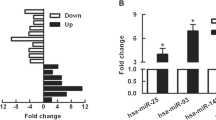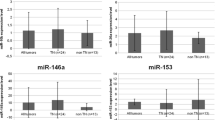Abstract
New concepts in epigenetics, microRNAs, and gene expression analysis have significantly enhanced knowledge of cancer pathogenesis over the last decade. MicroRNAs (miRNAs) are a class of non-coding RNAs that regulate gene expression by base pairing with target messenger RNAs (mRNAs), resulting in the repression of translation or the degradation of mRNA. To compare the carcinogenic process in tumors with different prognoses, we used real-time RT-PCR to evaluate the miRNA expression profiles of 24 triple-negative breast invasive ductal carcinoma, 20 luminal A breast invasive ductal carcinoma, and 13 normal breast parenchyma controls. We extracted total RNA from tissues fixed in formol and embedded in paraffin (FFPE). Results revealed the upregulation of miR-96-5p (9.35-fold; p = 0.000115), miR-182-5p (7.75-fold; p = 0.000033), miR-7-5p (6.71-fold; p = 0.015626), and miR-21-5p (6.10-fold; p = 0.000000) in tumors group. In addition, the expression of miR-125b-5p (4.49-fold; p = 0.000000) and miR-205-5p (4.36-fold; p = 0.006098) was downregulated. When the expression profiles of triple-negative and luminal A tumors were compared, there was enhanced expression of miR-17-5p (4.27-fold; p = 0.000664), miR-18a-5p (9.68-fold; p = 0.000545), and miR-20a-5 (4.07-fold; p = 0.001487) in the triple-negative tumors compared with luminal A. These data suggest that there is a similar regulation of certain miRNAs in triple-negative and luminal A tumors. However, it is possible that differences in the expression of miR-17-92 cluster will explain the phenotypic differences between these molecular tumor subtypes.



Similar content being viewed by others
References
Khoshnaw SM, Green AR, Powe DG, Ellis IO. MicroRNA involvement in the pathogenesis and management of breast cancer. J Clin Pathol. 2009;62:422–8.
Lynam-Lennon N, Maher SG, Reynolds JV. The roles of microRNA in cancer and apoptosis. Biol Rev. 2009;84:55–71.
Hutvagner G, Zamore PD. A microRNA in a multiple-turnover RNAi enzyme complex. Science. 2002;297:2056–60.
Humphreys DT, Westman BJ, Martin DI, Preiss T. MicroRNAs control translation initiation by inhibiting eukaryotic initiation fator 4E/cap and poly(A) tail function. Proc Natl Acad Sci U S A. 2005;102:16961–6.
Nottrott S, Simard MJ, Richter JD. Human let-7a miRNA blocks protein production on actively translating polyribosomes. Nat Struct Mol Biol. 2006;13(12):1108–14.
Chen L, Li Y, Fu Y, Peng J, Mo MH, Stamatakos M, et al. Role of deregulated microRNAs in breast cancer progression using FFPE tissue. PLoS One. 2013;8:e54213.
Voduc KD, Cheang MC, Tyldesley S, Gelmon K, Nielsen TO, Kennecke H. Breast cancer subtypes and the risk of local and regional relapse. J Clin Oncol. 2010;28(10):1684–91.
Sørliea T, Perou CM, Tibshirani R, Turid A, Geislerg S, Johnsen H, et al. Gene expression patterns of breast carcinomas distinguish tumor subclasses with clinical implications. Proc Natl Acad Sci U S A. 2001;98:10869–74.
Nielsen TO, Hsu FD, Jensen K, Cheang M, Karaca G, Hu Z, et al. Immunohistochemical and clinical characterization of the basal-like subtype of invasive breast carcinoma. Clin Cancer Res. 2004;10:5367–74.
Guttilla IK, White BA. Coordinate regulation of FOXO1 by miR-27a, miR-96, and miR-182 in breast cancer cells. J Biol Chem. 2009;284:23204–16.
Lin H, Dai T, Xiong H, Zhao X, Chen X, Yu C, et al. Unregulated miR-96 induces cell proliferation in human breast cancer by downregulating transcriptional factor FOXO3a. PLoS One. 2010;5:e15797.
Krishnan K, Steptoe AL, Martin HC, Wani S, Nones K, Waddell N, et al. MicroRNA-182-5p targets a network of genes involved in DNA repair. RNA. 2013;19:230–42.
Segura MF, Hanniford D, Menendez S, Reavie L, Zou X, Alvarez-Diaz S, et al. Aberrant miR-182 expression promotes melanoma metastasis by repressing FOXO3 and microphthalmia-associated transcription factor. Proc Natl Acad Sci. 2009;106:1814–9.
Myatt SS, Wang J, Monteiro LJ, Christian M, Ho KK, Fusi L, et al. Definition of microRNAs that repress expression of the tumor suppressor gene FOXO1 in endometrial cancer. Cancer Res. 2010;70:367–77.
Cho WC, Chow AS, Au JS. Restoration of tumour supressor hsa-miR-145 inhibits cancer cell growth in lung adenocarcinoma patients with epidermal growth factor receptor mutation. Eur J Cancer. 2009;45:2197–206.
Schaefer A, Jung M, Mollenkopf HJ, Wagner I, Stephan C, Jentzmik F, et al. Diagnostic and prognostic implications of microRNA profiling in prostate carcinoma. Int J Cancer. 2010;126:1166–76.
Sarver AL, French AJ, Borralho PM, Thayanithy V, Oberg AL, Silverstein KA, et al. Human colon cancer profiles show differential microRNA expression depending on mismatch repair status and are characteristic of undifferentiated proliferative states. BMC Cancer. 2009;9:401.
Moskwa P, Buffa FM, Pan Y, Panchakshari R, Gottipati P, Muschel RJ, et al. miR-182-mediated downregulation of BRCA1 impacts DNA repair and sensitivity to PARP inhibitors. Mol Cell. 2011;41:210–20.
Sun Y, Fang R, Li C, Li L, Li F, Ye X, et al. Hsa-miR-182 suppresses lung tumorigenesis through down regulation of RGS17 expression in vitro. Biochem Biophys Res Commun. 2010;396:501–7.
Kong WQ, Bai R, Liu T, Cai CL, Liu M, Li X, et al. MicroRNA-182 targets cyclic adenosine monophosphate responsive elemento binding protein 1 (CREB1) and suppresses cell growth in human gastric adenocarcinoma. FEBS J. 2012;279:1252–60.
Liu Z, Liu J, Segura MF, Shao C, Lee P, Gong Y, et al. Mir-182 overexpression in tumourigenesis of high-grade serous ovarian carcinoma. J Pathol. 2012;228(2):204–15.
Weeraratne SD, Amani V, Teider N, Pierre-Francois J, Winter D, Kye MJ, et al. Pleiotropic effects of miR-183 ~ 96 ~ 182 converge to regulate cell survival, proliferation and migration in medulloblastoma. Acta Neuropathol. 2012;123:539–52.
Giles KM, Brown RA, Epis MR, Kalinowski FC, Leedman PJ. miRNA-7-5p inhibits melanoma cell migration and invasion. Biochem Biophys Res Commun. 2013;430:706–10.
Ozgün A. MicroRNA-21 as an indicator of aggressive phenotype in breast cancer. Onkologie. 2013;36:115–8.
Li J, Zhang Y, Zhang W, Jia S, Tian R, Kang Y, et al. Genetic heterogeneity of breast cancer metastasis may be related to miR-21 regulation of TIMP-3 in translation. Int J Surg Oncol. 2013;2013:875078.
Niu J, Shi Y, Tan G, Yang CH, Fan M, Pfeffer LM, et al. DNA damage induces NF-KB- dependent microRNA-21 up-regulation and promotes breast cancer cell invasion. J Biol Chem. 2012;287:21783–95.
Hong L, Yang J, Han Y, Lu Q, Cao J, Syed L. High expression of miR-210 predicts poor survival in patients with breast cancer: a meta-analysis. Gene. 2012;507:135–8.
Toyama T, Kondo N, Endo Y, Sugiura H, Yoshimoto N, Iwasa M, et al. High expression of microRNA-210 is an independent factor indicating a poor prognosis in Japanese triple-negative breast cancer patients. Jpn J Clin Oncol. 2012;42:256–63.
Rothé F, Ignatiadis M, Chaboteaux C, Haibe-Kains B, Kheddoumi N, Majjaj S, et al. Global microRNA expression profiling identifies MiR-210 associated with tumor proliferation, invasion and poor clinical outcome in breast cancer. PLoS One. 2011;6:e20980.
Zhou M, Liu Z, Zhao Y, Ding Y, Liu H, Xi Y, et al. MicroRNA-125b confers the resistance of breast cancer cells to paclitaxel through suppression of pro-apoptotic Bcl-2 antagonist killer 1 (Bak1) expression. J Biol Chem. 2010;285:21496–507.
Piovan C, Palmieri D, Di Leva G, Braccioli L, Casalini P, Nuovo G, et al. Oncosuppressive role of p53-induced miR-205 in triple negative breast cancer. Mol Oncol. 2012;6:458–72.
Mahamodhossen YA, Liu W, Rong-Rong Z. Triple-negative breast cancer: new perspectives for novel therapies. Med Oncol. 2013;30:653.
Li H, Bian C, Liao L, Li J, Zhao RC. miR-17-5p promotes human breast cancer cell migration and invasion through suppression of HBP1. Breast Cancer Res Treat. 2011;126:565–75.
Yang X, Du WW, Li H, Liu F, Khorshidi A, Rutnam ZJ, et al. Both mature miR-17-5p and passenger strand miR-17-3p target TIMP3 and induce prostate tumor growth and invasion. Nucleic Acids Res. 2013;41:9688–704.
Kyounghyun K, Gayathri C, Syng-ook L, Daisuke Y, Sastre-Garau X, Pierre-Antoine D, et al. Identification of oncogenic microrna-17-92/ZBTB4/specificity protein axis in breast cancer. Oncogene. 2012;31(8):1034–44.
Zuoren Y, Chenguang W, Min W, Zhiping L, Mathew CC, Manran L, et al. A cyclin D1/microRNA 17/20 regulatory feedback loop in control of breast cancer cell proliferation. J Cell Biol. 2008;182(3):509–17.
Zuoren Y, Nicole EW, Jie Z, Sanjay K, Min W, Yang L, et al. microRNA 17/20 inhibits cellular invasion and tumor metastasis in breast cancer by heterotypic signaling. PNAS. 2010;107(18):8231–6.
Zhang ZW, An Y, Teng CB. The roles of miR-17-92 cluster in mammal development and tumorigenesis. Yi Chuan. 2009;31:1094–100.
Guo X, Yang C, Qian X, Lei T, Li Y, Shen H, et al. Estrogen receptor α regulates ATM expression through miRNAs in breast cancer. Clin Cancer Res. 2013;19:4994–5002.
Leivonen SK, Mäkelä R, Ostling P, Kohonen P, Haapa-Paananen S, Kleivi K, et al. Protein lysate microarray analysis to identify microRNAs regulating estrogen receptor signaling in breast cancer cell lines. Oncogene. 2009;28:3926–36.
Yoshimoto N, Toyama T, Takahashi S, Sugiura H, Endo Y, Iwasa M, et al. Distinct expressions of microRNAs that directly target estrogen receptor α in human breast cancer. Breast Cancer Res Treat. 2011;130:331–9.
Jonsdottir K, Janssen SR, Da Rosa FC, Gudlaugsson E, Skaland I, Baak JP, et al. Validation of expression patterns for nine miRNAs in 204 lymph-node negative breast cancers. PLoS One. 2012;7:e48692.
Leandro C, Georgios G, Jimmy J, Coombesa RC, Walter L, Paul T, et al. The estrogen receptor-induced microRNA signature regulates itself and its transcriptional response. PNAS. 2009;106(37):15732–7.
Acknowledgments
This research was funded by Fundação de Amparo à Pesquisa do Estado de São paulo—FAPESP, São Paulo-SP, Brazil.
Conflicts of interest
None
Author information
Authors and Affiliations
Corresponding author
Rights and permissions
About this article
Cite this article
Calvano Filho, C.M.C., Calvano-Mendes, D.C., Carvalho, K.C. et al. Triple-negative and luminal A breast tumors: differential expression of miR-18a-5p, miR-17-5p, and miR-20a-5p. Tumor Biol. 35, 7733–7741 (2014). https://doi.org/10.1007/s13277-014-2025-7
Received:
Accepted:
Published:
Issue Date:
DOI: https://doi.org/10.1007/s13277-014-2025-7




